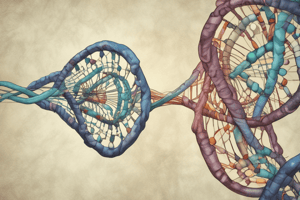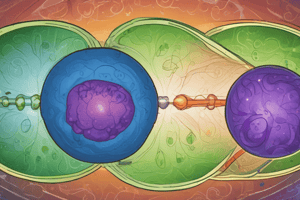Podcast
Questions and Answers
What does the principle of independent assortment state?
What does the principle of independent assortment state?
- Genes for different traits are inherited together.
- Alleles for different traits segregate independently. (correct)
- Genes always influence each other's inheritance.
- Dominant alleles cannot be recessive.
In Mendel's F2 generation, what ratio did he observe for the traits studied?
In Mendel's F2 generation, what ratio did he observe for the traits studied?
- 9:3:3:1 (correct)
- 3:1
- 2:1
- 1:2:1
What is true about alleles in relation to dominance and recessiveness?
What is true about alleles in relation to dominance and recessiveness?
- Recessive alleles are always expressed in the phenotype.
- Dominant alleles do not affect trait expression.
- Some alleles may be dominant while others are recessive. (correct)
- All alleles are equally dominant.
What did Mendel’s experiments establish about genes?
What did Mendel’s experiments establish about genes?
Which organism did Thomas Hunt Morgan use for advancing the study of genetics?
Which organism did Thomas Hunt Morgan use for advancing the study of genetics?
What is the probability of getting heads up on a single coin flip?
What is the probability of getting heads up on a single coin flip?
What is the probability of getting heads up on three consecutive coin flips?
What is the probability of getting heads up on three consecutive coin flips?
In Mendel's F1 generation, what is the probability of a gamete carrying the recessive allele?
In Mendel's F1 generation, what is the probability of a gamete carrying the recessive allele?
In Mendel's F2 generation, what is the probability of an offspring having the homozygous recessive genotype (gg)?
In Mendel's F2 generation, what is the probability of an offspring having the homozygous recessive genotype (gg)?
What term describes an organism with two identical alleles for a particular gene?
What term describes an organism with two identical alleles for a particular gene?
How does probability relate to the average outcomes in inheritance?
How does probability relate to the average outcomes in inheritance?
What is the primary contribution of Gregor Mendel to our understanding of genetics?
What is the primary contribution of Gregor Mendel to our understanding of genetics?
Why are Mendel's ratios not always perfectly matched in small F2 generations?
Why are Mendel's ratios not always perfectly matched in small F2 generations?
What term describes the physical traits of an organism?
What term describes the physical traits of an organism?
In Mendel’s experiments, what were the possible genotypes of pea plants with green pods?
In Mendel’s experiments, what were the possible genotypes of pea plants with green pods?
What is the purpose of a Punnett Square in genetics?
What is the purpose of a Punnett Square in genetics?
What did Mendel's two-factor cross reveal about dominant alleles?
What did Mendel's two-factor cross reveal about dominant alleles?
Which genotypes were found in the F1 generation from Mendel's cross of round yellow peas and wrinkled green peas?
Which genotypes were found in the F1 generation from Mendel's cross of round yellow peas and wrinkled green peas?
During Mendel's F2 generation, how many seeds produced were round and yellow?
During Mendel's F2 generation, how many seeds produced were round and yellow?
What type of genetic cross involves following two different genes?
What type of genetic cross involves following two different genes?
Which combination represents the genotype of true-breeding round yellow peas?
Which combination represents the genotype of true-breeding round yellow peas?
Flashcards
Probability
Probability
The likelihood of a particular event occurring.
Segregation of alleles
Segregation of alleles
Alleles separate randomly during gamete formation, just like flipping a coin.
Homozygous
Homozygous
Individuals with two identical alleles for a specific gene.
Heterozygous
Heterozygous
Signup and view all the flashcards
Genotype
Genotype
Signup and view all the flashcards
Phenotype
Phenotype
Signup and view all the flashcards
Polygenic inheritance
Polygenic inheritance
Signup and view all the flashcards
Mendel's contribution to genetics
Mendel's contribution to genetics
Signup and view all the flashcards
Principle of Independent Assortment
Principle of Independent Assortment
Signup and view all the flashcards
Genes
Genes
Signup and view all the flashcards
Alleles
Alleles
Signup and view all the flashcards
Dominant Allele
Dominant Allele
Signup and view all the flashcards
Recessive Allele
Recessive Allele
Signup and view all the flashcards
Punnett Square
Punnett Square
Signup and view all the flashcards
Independent Assortment
Independent Assortment
Signup and view all the flashcards
Monohybrid Cross
Monohybrid Cross
Signup and view all the flashcards
Dihybrid Cross
Dihybrid Cross
Signup and view all the flashcards
F1 Generation
F1 Generation
Signup and view all the flashcards
F2 Generation
F2 Generation
Signup and view all the flashcards
Study Notes
Applying Mendel's Principles
- Objectives:
- Explain the use of probability to predict traits.
- Describe allele segregation when multiple genes are involved.
- Describe Gregor Mendel's contribution to genetics.
Probability & Heredity
- Probability: The likelihood of an event occurring.
- Example: Flipping a coin has two possible outcomes (heads or tails) with equal probability (50% for each).
- Independent events: The outcome of one event doesn't affect the outcome of another. For three coin flips in a row, each flip has a 1/2 probability of landing heads up. The probability of all three flips landing heads up is 1/2 x 1/2 x 1/2 = 1/8
- The chance of a single coin flip is 1 in 2.
Probability & Heredity Using Segregation
- Segregation: Alleles segregate randomly during gamete formation, similar to a coin flip.
- Mendel's F₁ cross: Each F₁ plant has one green pod allele and one yellow pod allele.
- Gamete formation & probability: Half of the gametes produced by an F₁ plant will carry the yellow allele (g). To produce a plant with yellow pods (gg) needs two gametes carrying the g allele (1/2 x 1/2 = 1/4).
Probability & Heredity Using Segregation
- Homozygous: Organisms with two identical alleles for a gene are homozygous (GG or gg).
- Heterozygous: Organisms with two different alleles for a gene are heterozygous (Gg).
- Example: If an F₂ gamete has a 1/2 chance of carrying g, the probability of two F₂ gametes carrying the g allele is 1/2 x 1/2 = 1/4.
Probability & Heredity: Genotype/Phenotype
- Phenotype: Observable physical traits (like color or height).
- Genotype: Genetic makeup (combination of alleles).
- Example: In Mendel's pea plants, all plants with GG or Gg have the green pod phenotype despite different genotypes.
- Probabilities average out over a large number of offspring; smaller numbers may not show expected ratios.
Probability & Heredity: Punnett Squares
- Punnett Squares: Use mathematical probability to predict genotype and phenotype combinations in genetic crosses.
- Steps:
- Determine possible gamete alleles from parents.
- Arrange gametes on a square
- Combine gamete alleles in boxes to visualize possible offspring genotypes.
Independent Assortment
- Independent assortment: The segregation of one pair of alleles doesn't influence the segregation of another pair. The gene determining seed shape does not affect the gene for seed color.
- Monohybrid cross: Follows one gene.
- Dihybrid cross: Follows two genes.
- Example : Seeds The genes for seed shape (round/wrinkled) and seed color (yellow/green) are independently assorted.
The Two-Factor Cross: F₁ Generation
- The F₁ generation from crossing true-breeding plants with round yellow peas (RRYY) and wrinkled green peas (rryy) produces offspring with the heterozygous genotype RrYy. These plants all produce round, yellow peas.
The Two-Factor Cross: F₂ Generation
- Crossing F₁ generation plants produces F₂ generation plants.
- F₂ offspring showed combinations of phenotypes not present in the parents indicating independent segregation of alleles.
- The ratio of phenotypes was approximately 9:3:3:1.
Summary of Mendel's Principles
- Mendel's principles form the basis of modern genetics.
- Traits are inherited through genes.
- Some alleles are dominant (masking the effect of recessive). Others are recessive.
- Each organism inherits two copies of each gene, one from each parent. These genes segregate during gamete formation.
- Alleles for different genes segregate independently.
- Principles apply to organisms beyond plants. Morgan used the fruit fly, Drosophila melanogaster to further study inheritance.
Studying That Suits You
Use AI to generate personalized quizzes and flashcards to suit your learning preferences.




